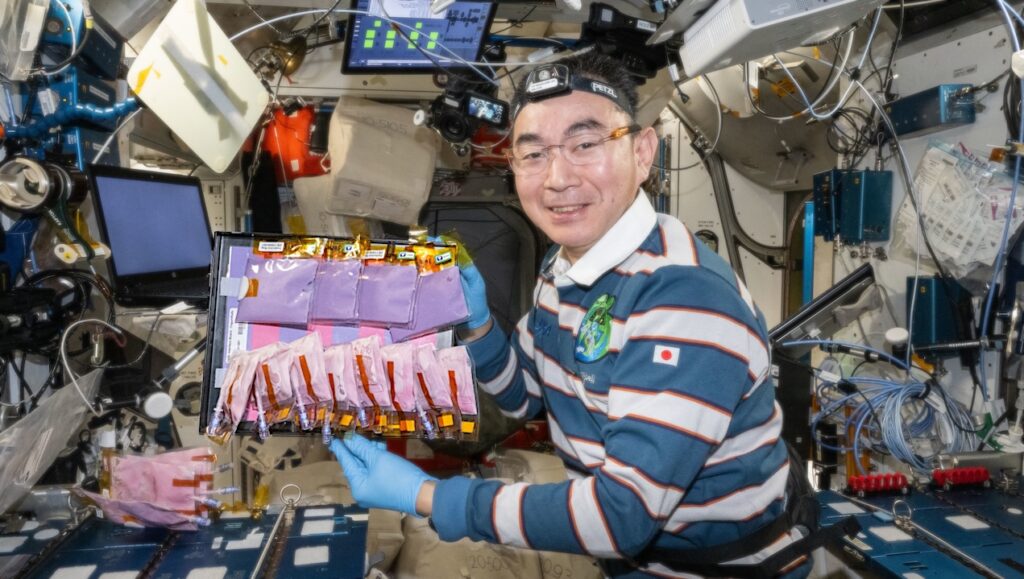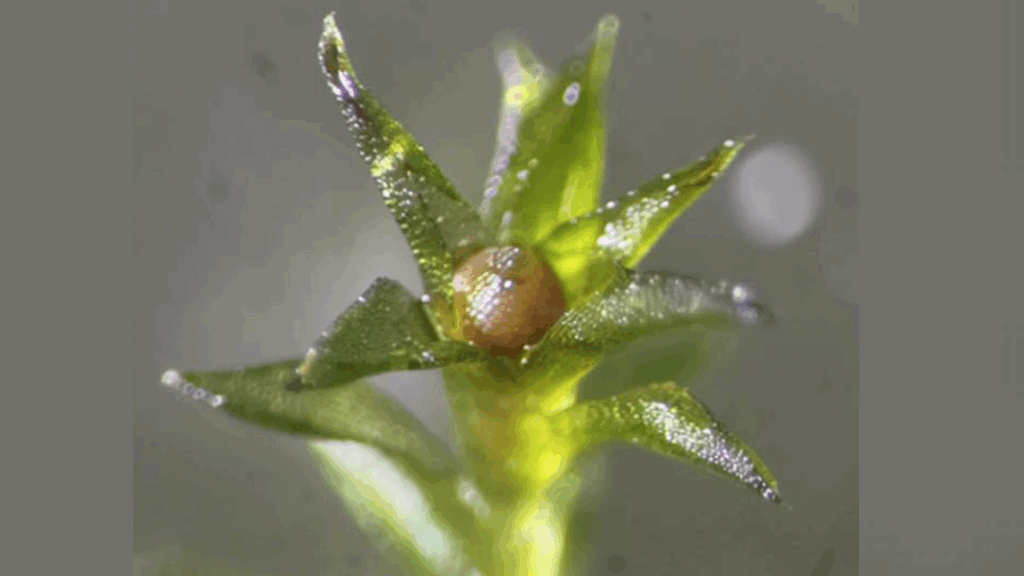NASA Spaceline Current Awareness List #1,090 8 March 20242 (Space Life Science Research Results)

Space Microbiology — NASA
Papers deriving from NASA support:
- Richmond SB, Seidler RD, Iliff JJ, Schwartz DL, Luther M, Silbert LC, Wood SJ, Bloomberg JJ, Mulder E, Lee JK, De Luca A, Piantino J.Dynamic changes in perivascular space morphology predict signs of spaceflight-associated neuro-ocular syndrome in bedrest.npj Microgravity. 2024 Mar 1;10(1):24.PI: R.D. SeidlerNote: Head-down tilt bedrest study. This article may be obtained online without charge.
Journal Impact Factor: 5.1
Funding: “This study was funded by National Aeronautics and Space Administration (NASA) [80NSSC17K0021 and 80NSSC18K0783 (PI: Rachael D. Seidler)], NIA Oregon Alzheimer’s Disease Research Center [NIA P30AG066518 (PI: Lisa C. Silbert)], and a NASA sponsored augmentation award (PI: Sutton B. Richmond).” - Cao X, Thomas D, Whitcomb LA, Wang M, Chatterjee A, Chicco AJ, Weil MM, Wu JC.Modeling ionizing radiation-induced cardiovascular dysfunction with human iPSC-derived engineered heart tissues.J Mol Cell Cardiol. 2024 Mar;188:105-7.PIs: X. Cao, A. Chatterjee, M.M. Weil, J.C. WuNote: This article is a letter to the editor.
Journal Impact Factor: 5.1
Funding: “This project was funded by Translational Research Institute for Space Health (TRISH) through NASA Cooperative Agreement NNX16AO69A (MMW, AJC, LW, MW, AC), 80ARC022CA003 (JCW), TRISH Postdoctoral Fellowship NNX16AO69A (XC), and National Institutes of Health (NIH) K99 HL163443-01A1 (DT), R01 HL141851, R01 HL145676, R01 HL150693, R01 HL171102, and UH3 TR002588 (JCW).” - O’Connor A, Park C, Baciak JE, Manuel MV.Mitigating space radiation using magnesium(-lithium) and boron carbide composites.Acta Astronaut. 2024 Mar;216:37-43.Note: From the abstract: “The health effects of galactic cosmic radiation are a serious impediment to crewed exploration of the solar system. OLTARIS, an interface for the 3DHZETRN deterministic radiation transport code, was used to assess the response of aerospace materials to this constant radiation exposure.”
Journal Impact Factor: 3.5
Funding: “This work was supported by a NASA Space Technology Research Fellowship, United States of America (award 80NSSC19K1163).” - Everroad RC, Foster JS, Galazka JM, Jansson JK, Lee JA, Lera MP, Perera IY, Ricco AJ, Szewczyk NJ, Todd PW, Zhang Y, Harrison L.Strategies, research priorities, and challenges for the exploration of space beyond low-Earth orbit.Gravit Space Res. 2024 Mar 5;12(1):18-40.Note: From the abstract: “NASA’s recent emphasis on human exploration of the Moon and, ultimately, Mars necessitates a transition from a focus of its research in the biological sciences from Low Earth Orbit (LEO) to platforms beyond LEO. Fundamental research questions need to be addressed to enable humans to thrive in deep space. Work beyond LEO necessitates a shift in technology and the utilization of organisms in autonomous experiments, especially in the near term. The Beyond LEO Instrumentation & Science Series Science Working Group (BLISS-SWG) was established to provide NASA’s Space Biology Program input on its strategy for developing research priorities and tools for exploration beyond LEO. Here, we present an abridged version of the first annual report of the BLISS-SWG, which is publicly available on the NASA Technical Reports Server.” This article may be obtained online without charge.
Journal Impact Factor: 2.5
Funding: “R.C. Everroad, J.M. Galazka, J.A. Lee, M.P. Lera, A.J. Ricco are affiliated with NASA Ames Research Center. Y. Zhang is affiliated with NASA John F. Kennedy Space Center.” - Shelat S, Marquez JJ, Zheng J, Karasinski JA.Collaborative system usability in spaceflight analog environments through remote bbservations.Appl Sci. 2024 Feb 28;14(5):2005.Note: This article is part of Special Issue “New Insights into Human-Computer Interaction” (https://www.mdpi.com/journal/applsci/special_issues/New_Insights_into_Human_Computer_Interaction) and may be obtained online without charge.
Journal Impact Factor: 2.7
Funding: “This research was funded in part by the NASA Human Research Program’s Human Factors and Behavior Performance Element (NASA Program Announcement number 80JSC017N0001-BPBA) Human Capabilities Assessment for Autonomous Missions (HCAAM) Virtual NASA Specialized Center of Research (VNSCOR) effort (NASA grant number 80NSSC19K0657).” - Liu GW, Pickett MJ, Kuosmanen JLP, Ishida K, Madani WAM, White GN, Jenkins J, Park S, Feig VR, Jimenez M, Karavasili C, Lal NB, Murphy M, Lopes A, Morimoto J, Fitzgerald N, Cheah JH, Soule CK, Fabian N, Hayward A, Langer R, Traverso G.Drinkable in situ-forming tough hydrogels for gastrointestinal therapeutics.Nat Mater. 2024 Feb 27.PIs: M. Jimenez, R. LangerNote: This article may be obtained online without charge.
Journal Impact Factor: 41.2
Funding: “This work was funded in part by the Bill & Melinda Gates Foundation Grant INV-009529 awarded to G.T. and R.L. M.J. was supported by the Translational Research Institute of Space Health through Cooperative Agreement NNX16AO69A. G.T. was supported in part by the Karl Van Tassel (1925) Career Development Professorship and Department of Mechanical Engineering, MIT.”
Other papers of interest:
- Cohen OE, Neuman S, Natan Y, Levy A, Blum YD, Amselem S, Bavli D, Ben Y.Amorphous calcium carbonate enhances osteogenic differentiation and myotube formation of human bone marrow derived mesenchymal stem cells and primary skeletal muscle cells under microgravity conditions.Life Sci Space Res. 2024 Mar 3. Online ahead of print.Note: ISS results.
- Bateman GA, Bateman AR.A perspective on the evidence for glymphatic obstruction in spaceflight associated neuro-ocular syndrome and fatigue.npj Microgravity. 2024 Feb 28;10:23. Review.Note: This article may be obtained online without charge.
- Mehare A, Chakole S, Wandile B.Navigating the unknown: A comprehensive review of spaceflight-associated neuro-ocular syndrome.Cureus. 2024 Feb;16(2):e53380. Review.
- Tomsia M, Cieśla J, Śmieszek J, Florek S, Macionga A, Michalczyk K, Stygar D.Long-term space missions’ effects on the human organism: What we do know and what requires further research.Front Physiol. 2024 Feb 12;15:1284644. Review.Note: This article may be obtained online without charge.
- Kuzichkin DS, Markin AA, Zhuravleva OA, Kocherguin AY, Nichiporuk IA.[Hemocoagulation system in ground experiments simulating the effects of spaceflight: Based on russian research materials.]Aviakosm Ekolog Med. 2024 Mar;28(1):17-24. Russian.Note: From the abstract: “This review presents the results of studying the hemocoagulation system in Soviet and Russian experiments modeling effects of some spaceflight factors on the human organism.”
- Rusanov VB, Yakhya YD, Orlov OI.[Heart rate variability as a marker of regulatory mechanisms of cardiovascular homeostasis in spaceflight.]Aviakosm Ekolog Med. 2024 Mar;58(1):25-31. Russian.
- Zhuravleva TV, Loguinov VI.[Psychological aspects of adaptation of the healthy human organism to simulated spaceflight factors in an experiment with 21-day dry immersion.]Aviakosm Ekolog Med. 2024 Mar;58(1):62-7. Russian.
- Lang A, Binneboessel S, Nienhaus F, Bruno RR, Wolff G, Piayda K, Pfeiler S, Ezzahoini H, Oehler D, Kelm M, Winkels H, Gerdes N, Jung C.Acute and short-term fluctuations in gravity are associated with changes in circulatory plasma protein levels.npj Microgravity. 2024 Mar 4;10:25.Note: From the article: “The study was conducted as part of the 36th PFC organized by the German Aerospace Centre [Deutsches Zentrum für Luft-und Raumfahrt (DLR)] in June 2021. On each flight day, 31 parabolic flight maneuvers were performed. The experiments took place on board a specifically equipped Airbus A310 aircraft, operated by the company Novespace (Bordeaux, France) and flown by three well-trained pilots.”
- Saeki Y, Wakabayashi K, Hoson T, Sasaki H, Oka M, Kitaya Y, Miyamoto K, Soga K.Effects of hypergravity in a centrifuge and simulated microgravity on a horizontal clinostat on tuber formation in single-nodal stem segments from potato (Solanum tuberosum L.) sprouts.Biological Sciences in Space. 2024 Mar;38:8-17.Note: A clinostat was used in this study. This article may be obtained online without charge.
- Yin Y, Li J, Xu C, Zeng D, Zhu Y, Wu X, Fan Q, Zhao S, Wang J, Liu Y, Li Y, Lu W.Whole-transcriptome RNA sequencing reveals CeRNA regulatory network under long-term space composite stress in rats.Life Sci Space Res. 2024 May;41:136-145.
- Ivanov IV, Burmistrov VI, Matkevich EI.[Analysis of probable radiation levels to cosmonauts in a short-term lunar mission.]Aviakosm Ekolog Med. 2024 Mar;58(1):32-46. Russian.
- Samoilenko TV, Shishkina VV, Antakova LN, Goryushkina ES, Atiakshin DA.[Actin of smooth muscle cells as a criterion of gravity-sensitivity of the gastrointestinal tract of mice and mongolian gerbils.]Aviakosm Ekolog Med. 2024 Mar;58(1):102-10. Russian.
- Ukraintseva YV, Zhurina YD, Lazarev IE, Tomilovskaya ES.[Comparison of EEG changes at rest during 21-day dry immersion and 21-day head-down bedrest.]Aviakosm Ekolog Med. 2024 Mar;58(1):55-61. Russian.Note: Head-down bedrest study.
- Mathur S, Bheemanahalli R, Jumaa SH, Kakar N, Reddy VR, Gao W, Reddy KR.Impact of ultraviolet-B radiation on early-season morpho-physiological traits of indica and japonica rice genotypes.Front Plant Sci. 2024 Feb 29;15:1369397.Note: This article may be obtained online without charge.
Astrobiology, space biology,








